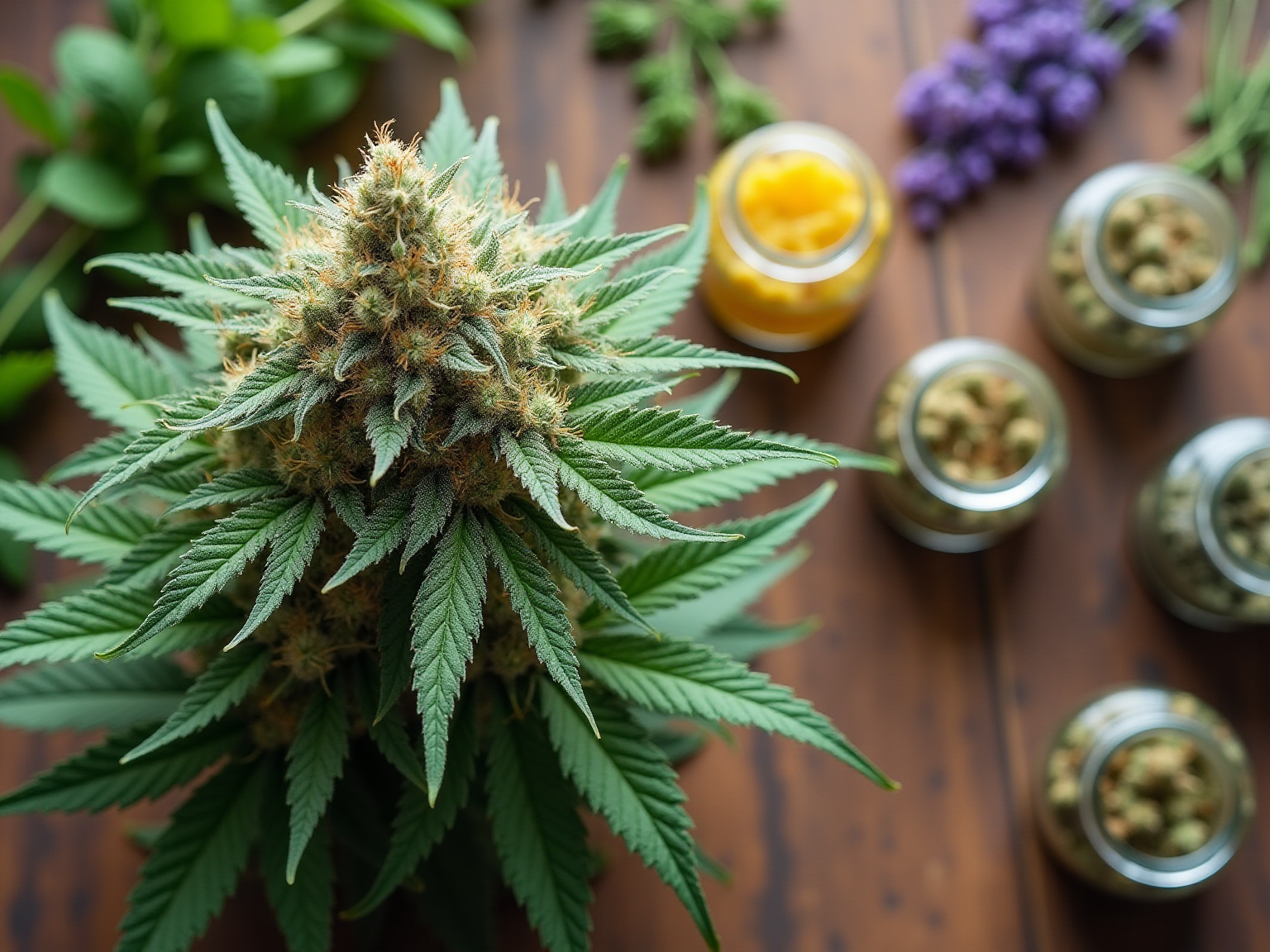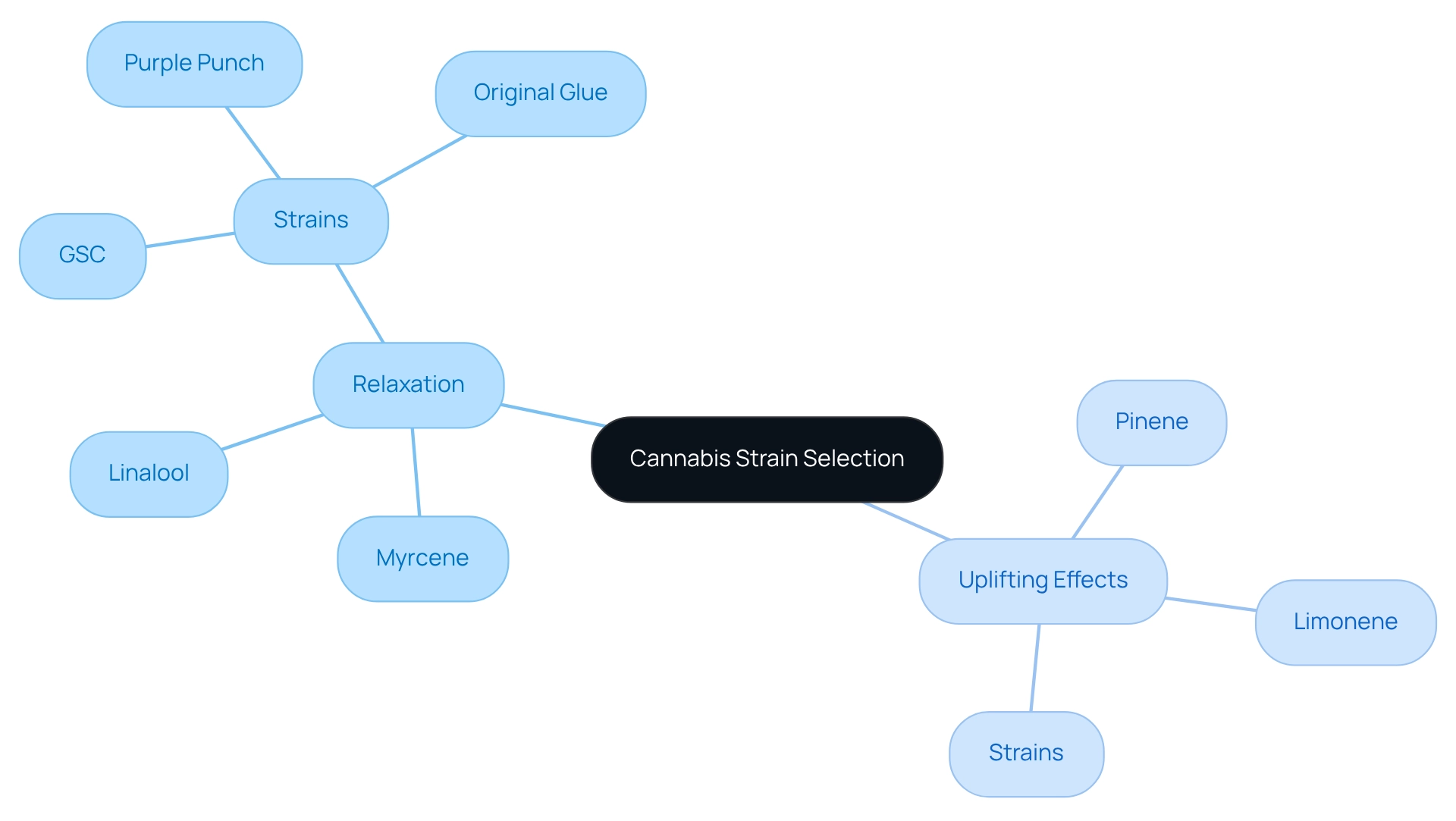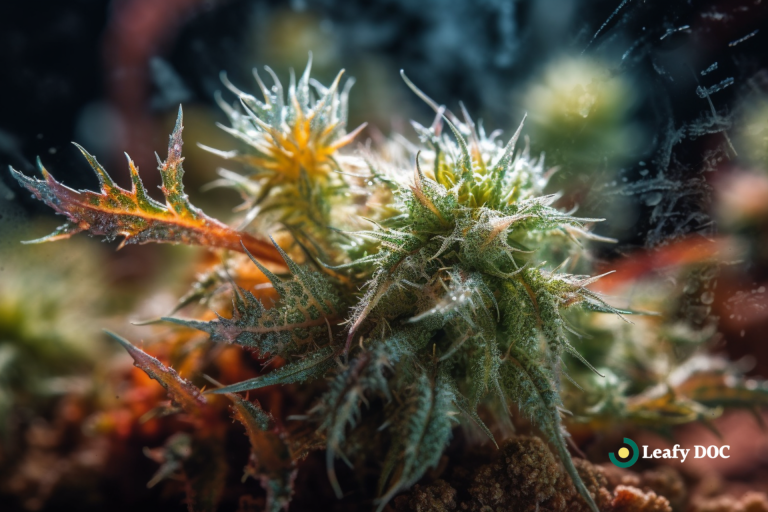Master the Terpene Chart for Enhanced Cannabis Selection
by Maya Green · May 2, 2025
Unlock the benefits of cannabis with our guide to reading terpene charts for better strain selection.

Overview
This article focuses on how you can effectively use a terpene chart to enhance your cannabis selection for therapeutic purposes. It’s important to remember that understanding terpenes and their specific effects—like myrcene for relaxation and limonene for mood enhancement—can empower you to choose cannabis strains that align with your health needs. By doing so, you can maximize the therapeutic benefits of marijuana, helping you feel more in control of your wellness journey.
You may find that selecting the right strain can significantly impact your overall experience. It’s not just about the cannabis itself; it’s about finding what works best for you. This understanding allows you to navigate your options with confidence, ensuring that your choices support your individual health goals.
As you explore the world of terpenes, remember that you are not alone in this journey. Many patients share similar struggles, and by connecting with this knowledge, you take a meaningful step toward enhancing your well-being. Consider keeping a terpene chart handy as you make your selections, and don’t hesitate to reach out for support or share your experiences with others. Together, we can foster a community that prioritizes health and healing.
Introduction
In the intricate world of cannabis, terpenes play a pivotal role that goes beyond their aromatic contributions. These organic compounds not only define the unique scents and flavors of various strains but also possess remarkable therapeutic properties that can influence the effects experienced by users. For those living with chronic pain, understanding the significance of terpenes is essential for selecting strains that align with their health goals.
You may find that the calming effects of myrcene or the mood-enhancing qualities of limonene can provide relief and support. The diverse spectrum of terpenes offers a wealth of benefits that can enhance your overall cannabis experience. As research continues to unveil the complexities of these compounds, the potential for terpenes to improve quality of life for patients becomes increasingly evident. This highlights the importance of informed strain selection in your pursuit of effective pain management and wellness. Remember, you are not alone on this journey; exploring the right options can make a significant difference in your well-being.
Understand Terpenes and Their Importance in Cannabis
Terpenes are organic substances found in various plants, including marijuana, that contribute to the unique aromas and flavors of different strains. Produced in unique combinations, they also influence a plant’s appearance and play a role in natural defense by deterring predators and attracting pollinators. In cannabis, these compounds not only shape the scent and taste of each strain but also impact its therapeutic properties and overall effects.
For instance, myrcene is known for its sedative effects, making it a wonderful option for those in search of relaxation. Limonene, which constitutes 56% of the compounds in the popular ‘Girl Scout Cookies’ strain, is celebrated for its mood-enhancing and stress-relieving qualities—especially beneficial for chronic pain sufferers seeking relief.
Beyond cannabis, terpenes are abundant in nature—present in herbs, teas, citrus fruits, conifers, and spices like black pepper. They’re responsible for lavender’s calming scent, lemons’ citrus brightness, and the fresh aroma of pine. In plants, terpenes help defend against predators and attract pollinators through their vibrant fragrances.
Interestingly, terpenes have also been identified in some animals, such as in fish scales and egg yolks, though they are most diverse in the plant kingdom. Their widespread presence highlights their importance in both natural ecosystems and everyday sensory experiences—including your choice of cannabis strain.
Understanding these compounds is essential for chronic pain patients who wish to use a terpene chart to select the most suitable cannabis strain for their needs. Recent studies have highlighted the pain-relieving properties of compounds like:
- α-humulene
- geraniol
- linalool
- β-pinene
These compounds exhibit cannabimimetic activity, suggesting they can amplify the benefits of cannabinoids. This phenomenon, known as the ‘entourage effect,’ underscores the importance of terpenoids in enhancing therapeutic benefits.
A case study titled “Investigating the Analgesic Properties of Cannabis Compounds” examined the analgesic effects of substances found in Cannabis sativa, revealing that certain compounds can bolster cannabinoid effects, thereby supporting their use in pain management. Many veterans and cancer patients have shared significant improvements in their quality of life through the use of medical marijuana, often opting for it over traditional prescription medications due to its effectiveness and lower risk of addiction. One veteran recounted how using a strain rich in linalool helped alleviate his chronic pain and improve his sleep quality, illustrating the real-world benefits of understanding compound profiles.
Experts highlight that as research on plant compounds continues, their healing potential will likely receive greater recognition in the healthcare community. Real-life examples show how patients have benefited from understanding chemical profiles, empowering them to make informed choices that align with their health goals. By recognizing the significance of aromatic compounds detailed in the terpene chart, chronic pain patients can enhance their experience with marijuana and its therapeutic effects, ultimately improving their quality of life. Additionally, cannabis aroma profiles can be categorized into:
- earthy
- woody
- herbal
- citrus
- sweet
types, providing deeper insights into the variety of compounds and their potential effects.
Primary vs. Secondary Terpenes in Cannabis
Cannabis terpenes are often classified as primary or secondary based on their concentration and impact.
Primary terpenes appear in the highest amounts and play a major role in defining a strain’s aroma, flavor, and initial effects. Common examples include myrcene, known for its calming effects, and limonene, which offers mood-enhancing properties.
Secondary terpenes are present in smaller concentrations. While they may not dominate a strain’s profile, they add depth, subtle aroma variations, and can slightly influence therapeutic effects. This layered interaction between primary and secondary terpenes helps shape the overall experience of each cannabis strain.
Understanding the distinction between primary and secondary terpenes can improve your ability to choose strains that match your desired outcomes.
Indica vs. Sativa: Typical Effects and Therapeutic Use
Understanding the general effects of cannabis strain types can help guide your selection process.
Indica strains are commonly associated with deep relaxation, offering full-body calm that may help ease muscle tension, improve sleep, and relieve chronic pain. These strains are often preferred for evening or nighttime use.
In contrast, Sativa strains tend to produce uplifting, energizing effects. Many users report enhanced creativity, increased focus, and improved mood. Sativa options are typically used during the day for managing fatigue, low motivation, or mild mood disturbances.
While individual responses may vary, these general traits can help you choose strains that best align with your lifestyle and therapeutic goals.
Herbs, Spices, and Teas That Contain Terpenes
Terpenes aren’t exclusive to cannabis—many common herbs, spices, and teas also contain these beneficial compounds.
Turmeric, widely used in Indian cuisine, is known for its anti-inflammatory and pain-relieving properties. Thyme, popular in Mediterranean cooking, offers antibacterial and antifungal effects that support overall wellness.
Teas such as green tea, rooibos, and turmeric tea are also rich in therapeutic terpenes. These beverages may help reduce inflammation, relieve discomfort, and promote a sense of calm.
Incorporating terpene-rich foods and drinks into your routine can complement cannabis use and support a holistic approach to health and symptom relief.
Learn How to Read a Terpene Chart
To effectively read a compound chart, it’s important to start by identifying the substances listed along the side or top. Each compound typically includes a description that outlines its scent, taste, and possible effects. For instance, caryophyllene is known for its spicy aroma and potential anti-inflammatory properties, which can be particularly beneficial for those dealing with chronic pain. Myrcene, one of the most common compounds in cannabis, is present in 20 – 40% of contemporary cannabis varieties.
Next, take a moment to analyze the concentration levels of each compound in different varieties, often shown as percentages. You may find that greater concentrations frequently link to more noticeable outcomes related to that compound. Understanding prevalent compounds and their impacts is essential, as it empowers you to choose varieties that align with your intended results, especially when considering the medicinal advantages of CBD and the relaxation these compounds can offer.
Boiling Points of Common Cannabis Terpenes
Understanding the boiling points of cannabis terpenes can help you get the most out of your vaporizing experience. Each terpene activates at a specific temperature, influencing the aroma, flavor, and effects you feel. Adjusting your vaporizer temperature to match the terpene profile of your strain may enhance both enjoyment and therapeutic results.
Here’s a guide to common terpenes and their boiling points:
-
Pinene – 311°F (155°C): Fresh pine scent; known for anti-inflammatory effects.
-
Humulene – 223°F (106°C): Earthy and spicy; may suppress appetite and reduce inflammation.
-
Limonene – 349°F (176°C): Citrus aroma; promotes mood elevation and anxiety relief.
-
Myrcene – 333°F (167°C): Musky and earthy; associated with relaxation and “couch-lock.”
-
Borneol – 415°F (213°C): Minty aroma; offers potential pain-relieving and anti-inflammatory benefits.
-
Phytol – 399°F (204°C): Grassy and floral; may support sedation and stress relief.
-
Eucalyptol – 342°F (172°C): Refreshing menthol scent; linked to antibacterial and antifungal properties.
-
Sabinene – 326°F (163°C): Peppery and woodsy; may aid digestion and provide antioxidant support.
Keeping a terpene boiling point chart on hand can help you optimize your vaporizer settings and tailor your cannabis experience to better suit your wellness goals.
Research indicates that many consumers may not fully grasp the effects of these compounds, highlighting the importance of education in making informed decisions. Additionally, studies have shown that outdoor samples tend to have less oxidized and degraded cannabinoids than indoor samples, which can influence the quality and therapeutic potential of the plant. Case studies reveal that patients who utilize a terpene chart can effectively select strains that better meet their therapeutic needs, enhancing their overall experience. Leafy DOC’s telehealth services can provide valuable guidance in this journey, ensuring that you have access to the information and support you need.
For further education, consider exploring Leafy DOC’s resources on medical marijuana regulations and career opportunities in the marijuana industry. Consulting with a healthcare professional is always recommended before using marijuana for specific health needs. By becoming familiar with these profiles, you enable yourself to navigate the varied landscape of this plant more effectively.
Select Cannabis Strains Using Terpene Profiles
Choosing the right cannabis varieties begins with understanding the effects you hope to achieve. If relaxation is your goal, consider varieties rich in myrcene or linalool, known for their soothing properties. These can be particularly beneficial for managing chronic pain and anxiety. On the other hand, if you’re seeking an uplifting experience, look for varieties high in limonene or pinene, which can enhance your mood and energy levels.
Utilizing a terpene chart allows for a thorough comparison of various strains and their profiles; for instance, a strain with higher levels of both myrcene and caryophyllene may provide a blend of relaxation and anti-inflammatory benefits, making it ideal for managing chronic pain. Notably, Purple Punch contains a caryophyllene level of 0.3-0.7%, potentially boosting its effectiveness in alleviating chronic pain and inflammation.
Additionally, the scent and taste of different varieties play a crucial role in your overall experience and can influence therapeutic outcomes. Personal preferences in aroma and flavor can significantly enhance your enjoyment of the plant, making it vital to consider these factors alongside their therapeutic effects.
By aligning your selection with both your health needs and personal tastes, you can truly maximize the therapeutic benefits of cannabis, and the terpene chart emphasizes the importance of terpene profiles in your selection process, encouraging patients to choose strains that meet their specific health requirements.
Strains like GSC, Original Glue, and Purple Punch, which contain caryophyllene, are particularly effective for addressing chronic pain and inflammation. Understanding the role of the endocannabinoid system in managing various conditions can further enhance your selection process, as it regulates pain, mood, and inflammation.
By focusing on these profiles and the broader health benefits of medical marijuana, including its effects on conditions like epilepsy and cancer, you can make informed choices that improve your therapeutic outcomes. It’s important to remember that this content is for informational purposes only and is not intended as professional medical advice.
Explore Therapeutic Benefits of Common Terpenes
Common terpenes found in marijuana, such as myrcene, limonene, and linalool, offer unique therapeutic advantages that can significantly enhance your well-being. Myrcene, for instance, is particularly noted for its sedative properties, making it a wonderful option for those seeking better sleep and relaxation. Research suggests that myrcene may also have analgesic qualities, potentially helping with pain and inflammation reduction. This makes it an excellent choice for individuals like you who are looking for natural relief from chronic pain.
Limonene, with its uplifting citrus aroma, is associated with mood elevation and stress reduction, providing a refreshing option for those managing anxiety. Meanwhile, linalool, which has a soothing floral scent, is recognized for its anti-anxiety effects, promoting calmness and relaxation. Understanding these benefits can empower you to choose plant varieties that align with your health goals, as indicated by the terpene chart. For example, if you are facing anxiety, you may find strains rich in linalool particularly effective in enhancing your relaxation and overall sense of well-being, as indicated in a terpene chart. This knowledge allows you to harness the therapeutic potential of cannabis, enabling you to make informed choices that cater to your specific health needs. Furthermore, case studies, such as ‘Managing Pain Naturally with Cannabis,’ highlight the effectiveness of these compounds in real-life situations, showcasing how individuals have successfully used strains rich in myrcene, limonene, and linalool to alleviate chronic pain and anxiety.
It’s important to remember that while early results are promising, more studies are needed to fully understand the benefits of terpenes. Additionally, a-Pinene typically provides mildly stimulating effects paired with a sense of tranquility, rather than nervous jitters, adding another dimension to the therapeutic profile of the plant. Lastly, Farnesene, primarily found as β-Farnesene, is known for its distinctive ‘green apple’ scent, enriching the diverse aromatic profile of cannabis.
To effectively utilize this information, you may consider consulting with a healthcare professional to identify strains that best meet your therapeutic needs. Your journey towards better health is important, and having the right support can make all the difference.
Sabinene: Aromatic Profile and Potential Health Benefits
Sabinene is a lesser-known cannabis terpene with a spicy, peppery aroma often compared to pumpkin pie or holiday spices. Though not as common as myrcene or limonene, it adds a warm, earthy complexity to strains like Super Silver Haze.
Early research suggests Sabinene may offer antibacterial and antioxidant properties, making it a terpene worth noting for its potential therapeutic value alongside its distinctive scent.
Eucalyptol: Cooling Aroma and Wellness Potential
Eucalyptol is a cannabis terpene known for its crisp, minty, menthol-like scent, similar to eucalyptus leaves. Though found in smaller concentrations, it adds a refreshing layer to the aroma of strains like Girl Scout Cookies, AC/DC, and Headband.
Research shows that eucalyptol may offer anti-bacterial and anti-fungal benefits, supporting its potential use in holistic wellness. While studies are still ongoing, its long-standing role in traditional remedies makes it a notable terpene for therapeutic cannabis users.
Phytol: Floral Aroma and Calming Effects
Phytol is a cannabis terpene with a grassy, floral aroma that adds subtle herbal depth to strains like Sour Diesel, Blue Dream, and Cheese.
Known for its sedative and anti-anxiety properties, phytol may help promote relaxation and reduce inflammation. Its calming profile makes it a supportive option for those managing stress, discomfort, or chronic pain.
Borneol: Minty Scent and Pain Relief Potential
Borneol is a cannabis terpene known for its minty aroma and subtle metallic undertones. Found in strains like K13-Haze, Golden Haze, and Amnesia Haze, it offers a cooling fragrance that adds depth to the sensory profile of cannabis.
This terpene has shown potential anti-inflammatory and analgesic properties, making it a candidate for those exploring natural relief from pain and inflammation.
Conclusion
Understanding the significance of terpenes in cannabis is crucial for chronic pain patients seeking effective relief. These organic compounds not only contribute to the distinct aromas and flavors of various strains but also possess therapeutic properties that can enhance the overall effectiveness of cannabis. By familiarizing yourself with terpenes such as myrcene, limonene, and linalool, you can make informed decisions that align with your health goals, ultimately improving your quality of life.
Selecting the right cannabis strain involves utilizing terpene charts and understanding the specific effects associated with different terpenes. Whether your goal is relaxation, mood elevation, or pain relief, knowing which terpenes to look for can significantly influence the therapeutic outcomes you experience. The growing body of research underscores the potential of terpenes to work synergistically with cannabinoids, emphasizing the importance of the entourage effect in maximizing the benefits of cannabis.
As the medical community continues to explore the therapeutic potential of terpenes, you are empowered to take an active role in your wellness journey. By recognizing the diverse array of terpenes and their unique properties, you can navigate the complex landscape of cannabis more effectively. This knowledge not only enhances your cannabis experience but also supports better health management, making it an essential aspect of informed strain selection for those living with chronic pain.
Frequently Asked Questions
What are terpenes and why are they important in marijuana?
Terpenes are organic substances found in various plants, including marijuana, that contribute to the unique aromas and flavors of different strains. They also possess healing properties that can influence the effects of marijuana.
Can you give examples of terpenes and their effects?
Yes, for instance, myrcene is known for its sedative effects, making it suitable for relaxation. Limonene, which is prevalent in the ‘Girl Scout Cookies’ strain, is recognized for its mood-enhancing and stress-relieving qualities.
How can terpenes benefit chronic pain patients?
Chronic pain patients can use a terpene chart to select cannabis strains that best suit their needs. Some terpenes, such as α-humulene, geraniol, linalool, and β-pinene, have been highlighted for their pain-relieving properties. For instance, α-humulene, found in strains like Gelato, Atlantis, and Sour Diesel, offers both anti-inflammatory and appetite-suppressing effects alongside its earthy, woody aroma. β-pinene, one of the two structural isomers of pinene, is known for its earthy, pine-like aroma and may support respiratory function while offering anti-inflammatory and antibacterial benefits, especially in strains with uplifting effects.
What is the ‘entourage effect’?
The ‘entourage effect’ refers to the phenomenon where terpenoids amplify the benefits of cannabinoids, enhancing the therapeutic effects of cannabis.
What insights have recent studies provided regarding cannabis compounds?
Recent studies, such as ‘Investigating the Analgesic Properties of Cannabis Compounds,’ have shown that certain cannabis compounds can bolster the effects of cannabinoids, supporting their use in pain management.
How have patients benefited from understanding cannabis compound profiles?
Many patients, including veterans and cancer patients, have reported significant improvements in their quality of life by using medical marijuana, often choosing it over traditional medications due to its effectiveness and lower risk of addiction.
What types of cannabis aroma profiles exist?
Cannabis aroma profiles can be categorized into earthy, woody, herbal, citrus, and sweet types, providing insights into the variety of compounds and their potential effects.
How can understanding terpenes enhance the experience of using marijuana?
By recognizing the significance of aromatic compounds and utilizing a terpene chart, chronic pain patients can make informed choices that align with their health goals, ultimately improving their quality of life.
Last Updated: August 1, 2025
Get Approved for Your Medical Marijuana Card in Minutes!

Get Your Medical Card
Connect with a licensed physician online in minutes

Like This Article?
Share with your friends
Table of Contents
Keep Reading
-
What Are the 15 Conditions for Medical Marijuanas in Alabama?
Discover the 15 qualifying conditions for medical marijuana in Alabama and enhance your treatment options.
-
Do Cannabis Dispensaries Offer Black Friday Deals?
Find out if cannabis dispensaries are offering Black Friday deals and don’t miss out on potential discounts! Click now to uncover the best dispensary Black Friday deals near you.
-
Exploring Different Medical Marijuana Strains For Enhanced Patient Access
Find the perfect medical marijuana strain for your needs and unlock enhanced patient access. Experience the benefits of different strains today – click now!





